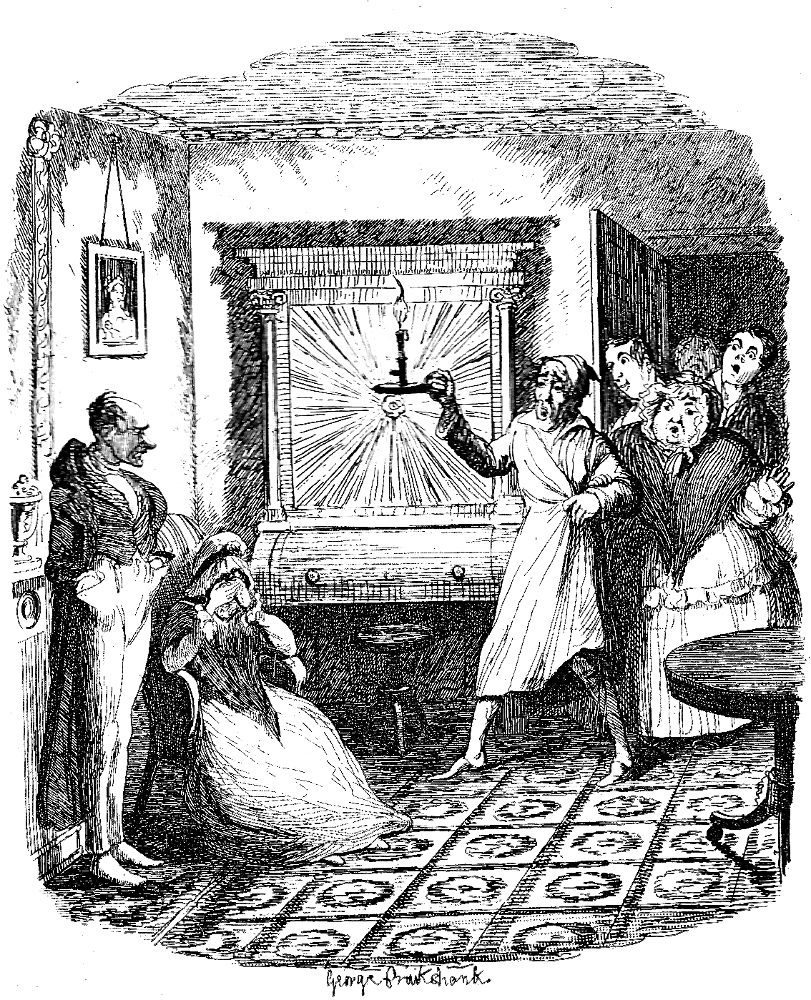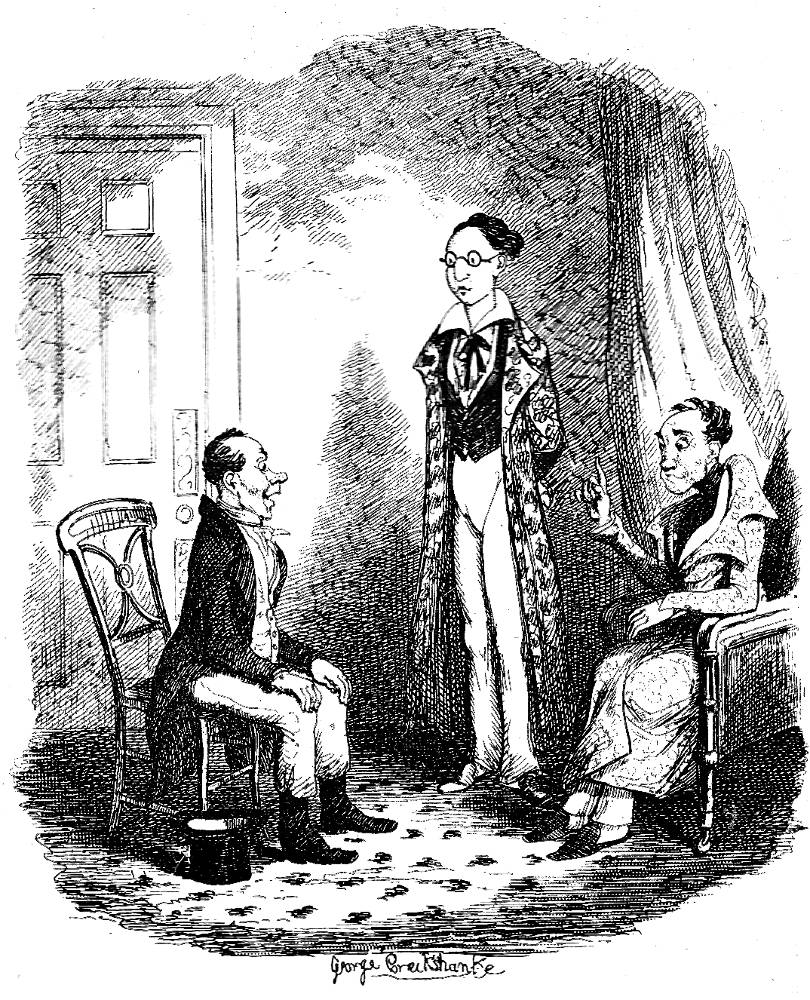
"Hush! Hush! Pray — Mrs. Tibbs —". Drawn by A. B. Frost. Wood engraving. For Part IV, "Tales": The second part of Chapter I, "The Boarding-House," in Dickens's Sketches by Boz Illustrative of Every-day Life and Every-Day People, page 205. Wood-engraving; 4 ⅛ by 5 3⁄16 inches (10.6 cm high by 13.3 cm wide), framed. The landlady, like Mr. Calton and Mr. Hicks in Frost's previous illustration for the story, reaches an erroneous conclusion about an impending elopement based on the meddling radical's incorrectly assuming that Wisbottle is courting the maid, Agnes.
Scanned image, colour correction, sizing, caption, and commentary by Philip V. Allingham. [You may use this image without prior permission for any scholarly or educational purpose, as long as you (1) credit the person who scanned the image, and (2) link your document to this URL in a web document or cite the Victorian Web in a print one.] Click on the image to enlarge it.
Bibliographical Information
The sketches which became "The Boarding-house" originally appeared as two separate articles in the Monthly Magazine (May and August numbers, 1834). Collected, these became the first of the short stories the "Tales" section in Dickens's Sketches by Boz Illustrative of Every-day Life and Every-Day People (1836 and 1839), illustrated in two separate copper-plate engravings by George Cruikshank. In the Household Edition (1876), Fred Barnard provided two regular illustrations, one for each part. The story was also illustrated by Sol Eytinge, Jr. in 1867, and by Harry Furniss in 1910 in the Diamond Edition and Chales Dickens Library Edition respectively.
Passage illustrated: Mr. Evenson attempts to implicate Mr. Wisbottle in Impropriety
One evening, the different inmates of the house were assembled in the drawing-room engaged in their ordinary occupations. Mr. Gobler and Mrs. Bloss were sitting at a small card-table near the centre window, playing cribbage; Mr. Wisbottle was describing semicircles on the music-stool, turning over the leaves of a book on the piano, and humming most melodiously; Alfred Tomkins was sitting at the round table, with his elbows duly squared, making a pencil sketch of a head considerably larger than his own; O’Bleary was reading Horace, and trying to look as if he understood it; and John Evenson had drawn his chair close to Mrs. Tibbs’s work-table, and was talking to her very earnestly in a low tone.
"I can assure you, Mrs. Tibbs," said the radical, laying his forefinger on the muslin she was at work on; "I can assure you, Mrs. Tibbs, that nothing but the interest I take in your welfare would induce me to make this communication. I repeat, I fear Wisbottle is endeavouring to gain the affections of that young woman, Agnes, and that he is in the habit of meeting her in the store-room on the first floor, over the leads. From my bedroom I distinctly heard voices there, last night. I opened my door immediately, and crept very softly on to the landing; there I saw Mr. Tibbs, who, it seems, had been disturbed also. — Bless me, Mrs. Tibbs, you change color!" [Part IV, "Tales," Chapter I, "The Boarding House," Chapter the Second, page 205]
Commentary: Setting up a Farcical Discovery Scene
The division between the first and second "chapters" of "The Boarding-House" in "Tales" reflects the piece's original serial and periodical publication circumstances, for the first chapter in "Tales" initially appeared as
Two sketches, originally published in the Monthly Magazine (May, August 1834), describing romantic intrigues in Mrs. Tibbs's boarding house in Great Coram Street [Bloomsbury]. In the first, the three male boarders (Mr. Simpson, Mr. Septimus Hicks, and Mr. Calton) each arrange secret marriages to Mrs. Maplestone and her two daughters. In the second, the presence of Mrs. Bloss, a hypochrondriac widow, prompts romantic intrigues among the male boarders. [Davis, p. 39]

George Cruikshank's The Boarding House II from Sketches (1836).
The earliest illustrator of the story, George Cruikshank, had produced an amusing tableau of the second "Boarding-house" discovery scene, in which Mrs. Tibbs and Mr. John Evenson are caught by the other boarders in a compromising position (although their suspicions are groundless). The second major illustrator, Fred Barnard, provided both realistic portraiture of the landlady and a gross caricature of the widow Mrs. Bloss in a second drawing-room scene which underscores the importance to the plot of her hypocondria and that of Mr. Gobler. After the discovery scene, depicted by Cruikshank in the 1836 and 1839 editions, the two hypocondriacs marry, thereby depriving the landlady of two valuable clients. Their departure from the Great Coram Street boarding-house signals its demise as Mrs. Tibbs sells up the furniture and parts company with her hen-pecked husband. To motivate Evenson's antipathy towards Wisbottle, Dickens earlier provides vital information about the "radical" Mr. Evenson's attitude towards the other boarder:
Mr. John Evenson was in the receipt of an independent income, arising chiefly from various houses he owned in the different suburbs. He was very morose and discontented. He was a thorough radical, and used to attend a great variety of public meetings, for the express purpose of finding fault with everything that was proposed. Mr. Wisbottle, on the other hand, was a high Tory. He was a clerk in the Woods and Forests Office, which he considered rather an aristocratic employment; he knew the peerage by heart, and, could tell you, off-hand, where any illustrious personage lived. He had a good set of teeth, and a capital tailor. Mr. Evenson looked on all these qualifications with profound contempt; and the consequence was that the two were always disputing, much to the edification of the rest of the house. [pp. 202-03]
In the Frost illustration, the politically Radical but personally censorious Mr. Evenson seizes the opportunity to implicate his personal and political opponent, Mr. Wisbottle (a Tory), in a plot to elope with the heiress Agnes. However, his persuading Mrs. Tibbs to join him in nocturnal surveillance of the bachelor and Agnes results in his being caught in a compromising position with the controlling landlady. The pair totally misapprehend the clandestine meeting between O'Bleary and Agnes, by which the Irishman hopes to enlist the maid's assistance in wooing her wealthy, hypocondrical employer, Mrs. Bloss.
In the illustration, Frost captures precisely the after-dinner atmosphere in the drawing-room of the London boarding-house with Wisbottle's melodiously tapping out a tune on the upright piano while others play cribbage. He exaggerates Evenson's awkward posture to suggest the energy with which he approaches his task of making Wisbottle the subject of the landlady's attempts to prevent further disruptions in her guest roster. She looks very grave, although she does not look up from embroidery.
Relevant Illustrations from Various Editions, 1839 through 1910



Left: George Cruikshank's expository illustration for the first instalment of the short story, The Boarding House, the discussion of the young women boarders by the male boarders, The Boarding House. (1839). Centre: Sol Eytinge, Jr.s's comic study of the drunken Mr. Tibbs's being confronted by his shrewish wife in The Boarding-House (1867). Right: Harry Furniss's comic study of a most animated Mr. Tibbs, trying to kiss one of the young, attractive housemaids, in The Boarding House: Mr. Tibbs (1910). [Click on the images to enlarge them.]

Above: Fred Barnard's second illustration for the story, in which the landlady, Mrs. Hicks, and Miss Bloss again misapprehend the true circumstances, "No what?" inquired Mrs. Bloss with a look of the most indescribable alarm (1876). [Click on the image to enlarge it.]
Bibliography
Ackroyd, Peter. Dickens: A Biography. London: Sinclair-Stevenson, 1990.
Bentley, Nicholas, Michael Slater, and Nina Burgis. The Dickens: Index. Oxford: Oxford U. P., 1990.
Cohen, Jane Rabb. Part One, "Dickens and His Early Illustrators: 1. George Cruikshank. Charles Dickens and His Original Illustrators. Columbus: Ohio University Press, 1980. Pp. 15-38.
Davis, Paul. Charles Dickens A to Z. The Essential Reference to His Life and Work. New York: Checkmark and Facts On File, 1998.
Dickens, Charles. "Tales," Chapter 1, "The Boarding-House,"Sketches by Boz, Illustrative of Every-day Life and Every-day People. Illustrated by George Cruikshank. London: Chapman and Hall, 1839; rpt., 1890. Pp. 205-34.
Dickens, Charles. "Tales," Chapter 1, "The Boarding-House." Christmas Books and Sketches by Boz, Illustrative of Every-day Life and Every-day People. Illustrated by Sol Eytinge, Jr. The Diamond Edition. Boston: James R. Osgood, 1875 [rpt. of 1867 Ticknor & Fields edition]. Pp. 305-10.
Dickens, Charles. "Tales," Chapter 1, "The Boarding-House." Sketches by Boz. Illustrated by Fred Barnard. The Household Edition. London: Chapman and Hall, 1876. Pp. 130-48.
Dickens, Charles. Part IV, "Tales," Chapter I, "The Boarding-House." Sketches by Boz. Illustrated by A. B. Frost. The Household Edition. New York: Harper and Bros., 1877. Pp. 194-208.
Dickens, Charles. "Tales," Chapter 1, "The Boarding-House." Sketches by Boz. Illustrated by Harry Furniss. The Charles Dickens Library Edition. London: Educational Book Company, 1910. I, 263-300.
Hawksley, Lucinda Dickens. Chapter 3, "Sketches by Boz." Dickens Bicentenary 1812-2012: Charles Dickens. San Rafael, California: Insight, 2011. Pp. 12-15.
Schlicke, Paul. "Sketches by Boz." Oxford Reader's Companion to Dickens. Oxford: Oxford U. P., 1999. Pp. 530-35.
Slater, Michael. Charles Dickens: A Life Defined by Writing. New Haven and London: Yale U. P., 2009.
Last modified 22 April 2019